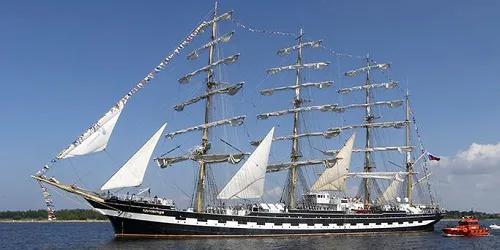-
Cruise Line InformationCarnival Cruise Line Cruising Guide & Tips Alcohol Prices & Selections Unlimited Soda Program "Cheers" Beverage Program Deck Plans Dry Dock Schedule Menus Food Recipes Beverage Recipes Secret Decks What's Included? What's Extra?
Celebrity Cruise Line Food Recipes Beverage Recipes
Disney Cruise Line Beverage Recipes
Holland America Line Food Recipes Beverage Recipes
Norwegian Cruise Line Cruising Guide & Tips Deck Plans What's Included? What's Extra?
Royal Caribbean Intl Cruising Guide & Tips Food Recipes Beverage Recipes Menus
-
Guest RegisterIf you are reading this it means you have not yet registered. Please take a second to REGISTER (it's FREE). You will then be able to enjoy all the features of Cruising Earth.
You should upgrade or use an alternative browser.
Kruzenshtern #3 Oldest Active Military Ship - Cruising Earth

Kruzenshtern - Russian Navy
#3 Oldest Active Military Ship
Kruzenshtern is currently ranked #3 in the list of the Oldest Active Military Ships.
3
In Service:
1926
(99 Years of Service)Ship StatisticsTrack Kruzenshtern
In Service: June 11, 1926
Gross Tonnage: 3,064 GT
Length: 375.00 Feet
Beam: 46.00 Feet
Speed: 17.3 knots / 19.9 mph
Complement: 257
Kruzenshtern Historical Brief
Introduction
The Russian sailing ship Kruzenshtern, originally named Padua, is one of the last remaining windjammers—a class of large sailing ships from the early 20th century. This four-masted barque has a rich history that spans from its construction in the 1920s to its current role as a training vessel and ambassador of maritime tradition for Russia. Over the years, Kruzenshtern has experienced significant historical events and transformations, making it an iconic vessel in both German and Russian maritime heritage.
Construction and Early Years: The German Era (1926-1946)
The ship was built in 1926 at the Joh. C. Tecklenborg shipyard in Geestemünde, Bremerhaven, Germany, for the F. Laeisz shipping company. Initially christened as Padua, the ship was part of the famous Flying P-Liners, a fleet of ships known for their speed and reliability in carrying cargoes. The Padua's design was a testament to the era's peak of sailing ship construction, with a length of 114.5 meters, a beam of 14.02 meters, and a height of 51.30 meters. The ship could carry around 3,556 tons of cargo and had a sail area of over 3,400 square meters, making it one of the most formidable cargo-carrying vessels of its time.
During its early years, the Padua primarily operated in the nitrate trade between Europe and South America, as well as in the wheat trade from Australia. These long voyages demanded a robust and efficient vessel, and the Padua proved to be both, earning a reputation for speed and reliability. The ship's ability to navigate the challenging conditions of the Cape Horn route was particularly notable, making it a critical asset in the global trade networks of the time.
Transition to Soviet Ownership (1946-1991)
Following World War II, the Padua was one of the German ships handed over to the Soviet Union as war reparations in 1946. Renamed Kruzenshtern in honor of the early 19th-century Russian explorer and admiral Adam Johann von Krusenstern, the ship entered a new phase of its life. Adam Johann von Krusenstern was renowned for leading the first Russian circumnavigation of the globe, and the renaming of the ship was a tribute to his contributions to maritime exploration.Under Soviet ownership, the Kruzenshtern was initially used for commercial purposes, transporting goods between the Soviet Union and various international ports. However, its role soon shifted towards training and education. The ship was repurposed as a training vessel for naval cadets, providing practical experience in navigation, seamanship, and maritime traditions. This transition marked the beginning of Kruzenshtern's long-standing legacy as a floating classroom and symbol of Soviet, and later Russian, maritime prowess.
Throughout the Cold War era, the Kruzenshtern participated in numerous international regattas and goodwill voyages, showcasing Soviet maritime capabilities and fostering international relations. The ship's visits to various ports around the world served as a means of cultural exchange and diplomacy, promoting the Soviet Union's image abroad. Notably, the Kruzenshtern took part in the Operation Sail events and other tall ship gatherings, where it was often a star attraction due to its historical significance and impressive presence.
Post-Soviet Era and Modern Use (1991-Present)
With the dissolution of the Soviet Union in 1991, the Kruzenshtern became part of the Russian Federation's maritime assets. The ship's ownership was transferred to the Baltic State Academy of the Fishing Fleet in Kaliningrad, where it continues to serve as a training vessel for maritime cadets. The Kruzenshtern's role in training future generations of seafarers is a continuation of its long-standing tradition of education and skill development.
Today, the Kruzenshtern is not only a training ship but also a floating museum and ambassador of Russian maritime heritage. It participates in numerous international sailing events, tall ship races, and regattas, maintaining its status as one of the most iconic sailing vessels in the world. The ship's voyages are meticulously planned to provide cadets with comprehensive training while also promoting cultural exchange and fostering goodwill between nations.
One of the notable aspects of Kruzenshtern's modern use is its involvement in scientific research. The ship has been used as a platform for various oceanographic studies, contributing to the understanding of marine environments and ecosystems. This scientific role underscores the versatility and continued relevance of the Kruzenshtern in the modern era.
Legacy and Cultural Significance
Throughout its history, the Kruzenshtern has been more than just a ship; it has been a symbol of maritime tradition, exploration, and international friendship. The vessel's endurance and adaptation through different historical epochs highlight its significance in naval history. Its participation in international events and its role in training generations of seafarers underscore its importance in the world of sailing.
The Kruzenshtern remains one of the largest traditional sailing ships still in operation today. It continues to inspire maritime enthusiasts and represents a living connection to the golden age of sail. Its storied past, from a German cargo vessel to a Soviet and then Russian training ship, encapsulates a century of maritime history and stands as a testament to the enduring allure of the sea.
The ship's historical significance is further enhanced by its association with notable maritime figures and events. The Kruzenshtern has been captained by some of the most skilled and respected sailors in the Soviet and Russian navies, and it has participated in numerous historic voyages and international regattas. The ship's logbooks and archives provide a rich source of information about its voyages and the experiences of those who served aboard it.
In addition to its training and cultural roles, the Kruzenshtern has also been involved in scientific research and exploration. The ship has been used as a platform for oceanographic studies and has contributed to our understanding of marine environments. This aspect of the Kruzenshtern's history underscores its versatility and the broad range of functions it has performed over the years.
Current Status and Future Prospects
As the Kruzenshtern approaches its centenary, it continues to be a symbol of resilience and adaptability. The ship's ability to survive and thrive through changing political, economic, and technological landscapes is a testament to the skill and dedication of those who have maintained and operated it over the decades. The Kruzenshtern's legacy is not only a reflection of its past achievements but also a promise of its continued relevance and contribution to maritime education and heritage.
In recent years, the ship has undergone various restorations and maintenance efforts to preserve its structural integrity and historical authenticity. These efforts ensure that the Kruzenshtern can continue to sail the world's oceans, educating and inspiring future generations of maritime professionals. The ship's participation in events like the Sail Training International (STI) races and other maritime festivals helps keep the spirit of traditional sailing alive in a rapidly changing world.
In conclusion, the Kruzenshtern's journey from a German cargo ship to a Soviet and then Russian training vessel encapsulates a century of maritime history and tradition. Its enduring presence on the world's oceans serves as a powerful reminder of the enduring allure of the sea and the timeless importance of maritime skills and knowledge. The Kruzenshtern stands as a living testament to the spirit of exploration, adventure, and international friendship that defines the world of sailing.
Cruising Earth Website Updates
The cruising industry is ever changing. The information contained on this site is updated frequently and kept as accurate as possible. If you believe any of the information is outdated, inaccurate, or you believe you have additional information that could be useful to other cruisers, please post the updated/new information in our Community Forums. Please use this same link to post any questions you may have.

